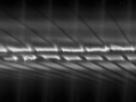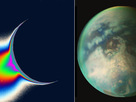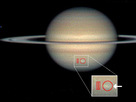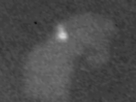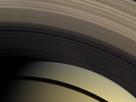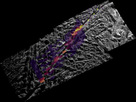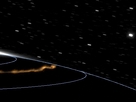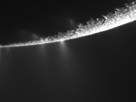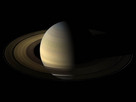Cassini
Hunting Enceladus 'Tigers' with Night Vision
NASA's Cassini spacecraft will be hunting for heat signatures at the "tiger stripes" in the dim south polar region of Saturn's moon Enceladus on Friday, Aug. 13. The closest approach will bring the spacecraft to within about 2,500 kilometers (1,600 miles) of the surface of Enceladus.
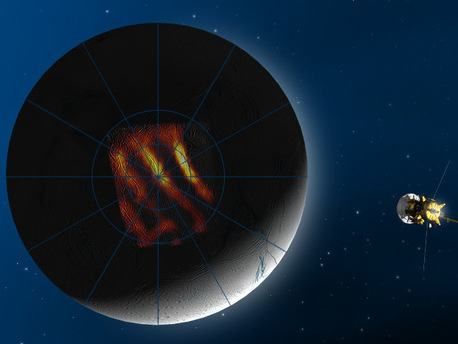 © NASA/JPL-Caltech |
Artist's concept of Cassini's flyby of Enceladus.
The tiger stripes -- which are actually giant fissures that spew jets of water vapor and organic particles hundreds of kilometers, or miles, out into space - are hard to see in the visible-light spectrum because winter is beginning to darken the moon's southern hemisphere. Cassini, however, has its own version of "night vision goggles" -- the composite infrared spectrometer instrument -- which can track heat even when visible light is low. The instrument will map temperatures in the transverse fractures between the tiger stripes Cairo Sulcus and Alexandria Sulcus. It will also scan part of the tiger stripe Damascus Sulcus.
The relatively high flyby allows the composite infrared spectrometer to track the tiger stripe surface smoothly throughout the flyby. That kind of coverage is more difficult at lower altitudes because the surface whooshes by very quickly.
In addition, the visual and infrared mapping spectrometer will collect data on the composition of Enceladus, and the imaging cameras will take pictures.
The Cassini-Huygens mission is a cooperative project of NASA, the European Space Agency and the Italian Space Agency. The Jet Propulsion Laboratory, a division of the California Institute of Technology in Pasadena, manages the Cassini-Huygens mission for NASA's Science Mission Directorate in Washington. The Cassini orbiter was designed, developed and assembled at JPL.
Source: NASA
The relatively high flyby allows the composite infrared spectrometer to track the tiger stripe surface smoothly throughout the flyby. That kind of coverage is more difficult at lower altitudes because the surface whooshes by very quickly.
In addition, the visual and infrared mapping spectrometer will collect data on the composition of Enceladus, and the imaging cameras will take pictures.
The Cassini-Huygens mission is a cooperative project of NASA, the European Space Agency and the Italian Space Agency. The Jet Propulsion Laboratory, a division of the California Institute of Technology in Pasadena, manages the Cassini-Huygens mission for NASA's Science Mission Directorate in Washington. The Cassini orbiter was designed, developed and assembled at JPL.
Source: NASA
Cassini
Hunting Enceladus 'Tigers' with Night Vision
NASA's Cassini spacecraft will be hunting for heat signatures at the "tiger stripes" in the dim south polar region of Saturn's moon Enceladus on Friday, Aug. 13. The closest approach will bring the spacecraft to within about 2,500 kilometers (1,600 miles) of the surface of Enceladus.
 © NASA/JPL-Caltech |
Artist's concept of Cassini's flyby of Enceladus.
The tiger stripes -- which are actually giant fissures that spew jets of water vapor and organic particles hundreds of kilometers, or miles, out into space - are hard to see in the visible-light spectrum because winter is beginning to darken the moon's southern hemisphere. Cassini, however, has its own version of "night vision goggles" -- the composite infrared spectrometer instrument -- which can track heat even when visible light is low. The instrument will map temperatures in the transverse fractures between the tiger stripes Cairo Sulcus and Alexandria Sulcus. It will also scan part of the tiger stripe Damascus Sulcus.
The relatively high flyby allows the composite infrared spectrometer to track the tiger stripe surface smoothly throughout the flyby. That kind of coverage is more difficult at lower altitudes because the surface whooshes by very quickly.
In addition, the visual and infrared mapping spectrometer will collect data on the composition of Enceladus, and the imaging cameras will take pictures.
The Cassini-Huygens mission is a cooperative project of NASA, the European Space Agency and the Italian Space Agency. The Jet Propulsion Laboratory, a division of the California Institute of Technology in Pasadena, manages the Cassini-Huygens mission for NASA's Science Mission Directorate in Washington. The Cassini orbiter was designed, developed and assembled at JPL.
Source: NASA
The relatively high flyby allows the composite infrared spectrometer to track the tiger stripe surface smoothly throughout the flyby. That kind of coverage is more difficult at lower altitudes because the surface whooshes by very quickly.
In addition, the visual and infrared mapping spectrometer will collect data on the composition of Enceladus, and the imaging cameras will take pictures.
The Cassini-Huygens mission is a cooperative project of NASA, the European Space Agency and the Italian Space Agency. The Jet Propulsion Laboratory, a division of the California Institute of Technology in Pasadena, manages the Cassini-Huygens mission for NASA's Science Mission Directorate in Washington. The Cassini orbiter was designed, developed and assembled at JPL.
Source: NASA





